|
Birds
30/09/18
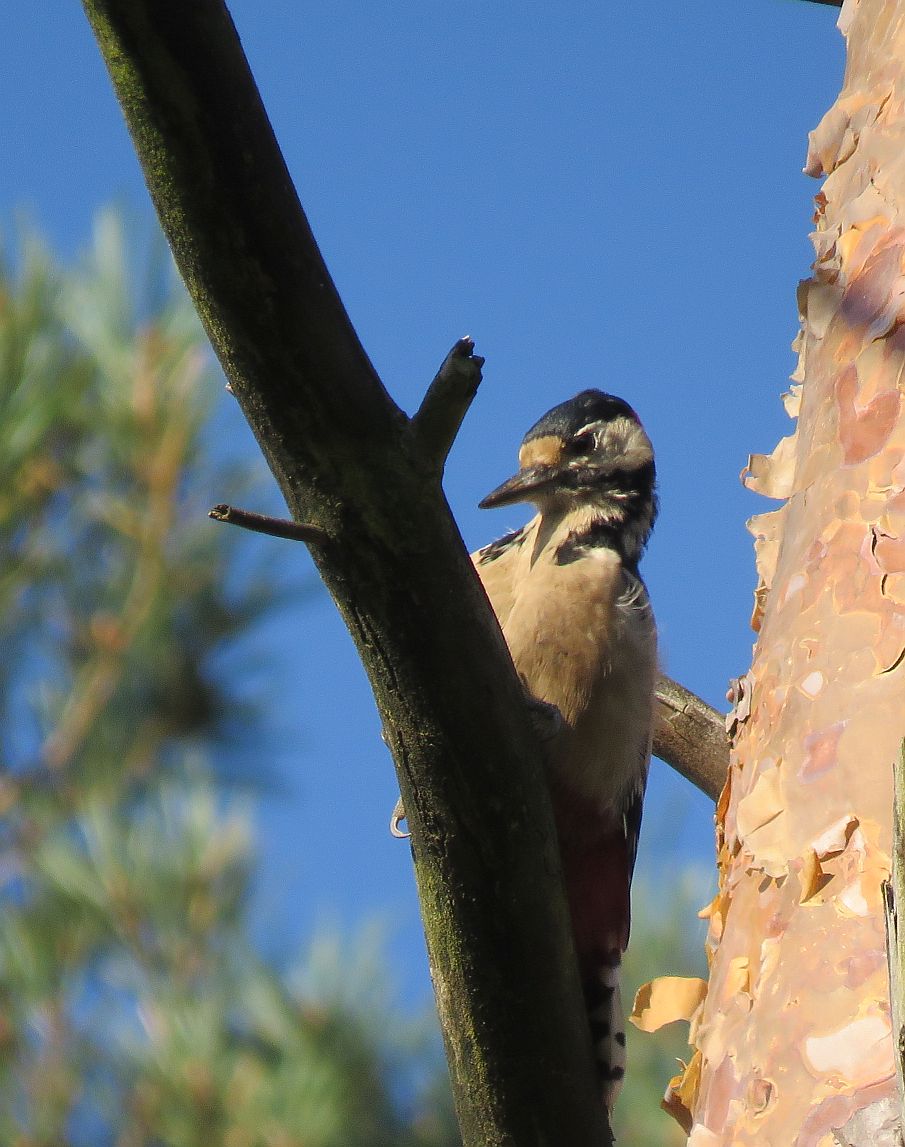 A stroll around Area 1 (Gorrick Woods) this morning and a Great spotted Woodpecker was tapping away at a dead Pine branch. A Green Woodpecker was heard calling as was a Chiffchaff . A Song Thrush was seen rummaging through the leaf litter.
A stroll around Area 1 (Gorrick Woods) this morning and a Great spotted Woodpecker was tapping away at a dead Pine branch. A Green Woodpecker was heard calling as was a Chiffchaff . A Song Thrush was seen rummaging through the leaf litter.
29/09/18
At the Area 5 feeders were Long tailed Tit , Blue Tit , Great Tit and Coal Tit .
27/09/18
 In Area 10 in glorious lunchtime sunshine a female Kestrel was sitting on the wires over the Car park field. 3 Jay flew across the field and a Nuthatch was calling from the nearby woods. 4 Blackcap were seen by Paul Bright Thomas.
In Area 10 in glorious lunchtime sunshine a female Kestrel was sitting on the wires over the Car park field. 3 Jay flew across the field and a Nuthatch was calling from the nearby woods. 4 Blackcap were seen by Paul Bright Thomas.
24/09/18
At lunch time in Area 10 a juvenile Osprey was calling as it briefly circled the field behind Bittern hide on Lavells Lake before flying off east, seen by David Williams-Jones and a Barn Owl was seen sitting at the door of the Barn Owl box in the same field by John Morgan.
23/09/18
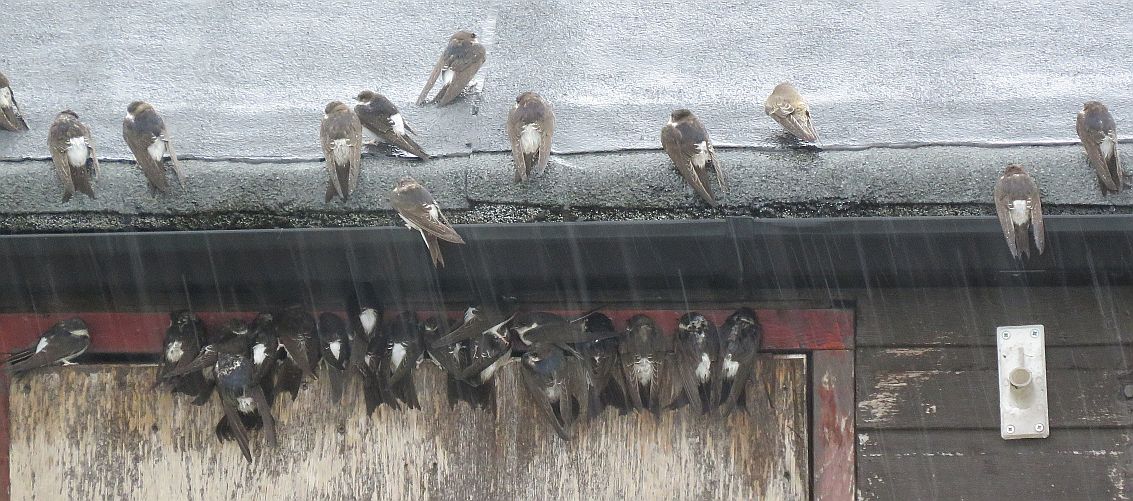 In Area 10 by the Dinton Activity Centre in the incessant rain this morning House Martin were once again feeding over the lake and the Emm, however approx 50 were sheltering/resting on the roof, doors and security lights of the Activity Centre .
In Area 10 by the Dinton Activity Centre in the incessant rain this morning House Martin were once again feeding over the lake and the Emm, however approx 50 were sheltering/resting on the roof, doors and security lights of the Activity Centre .  Several Swallow were also feeding over the lake. Several Swallow were also feeding over the lake.
22/09/18
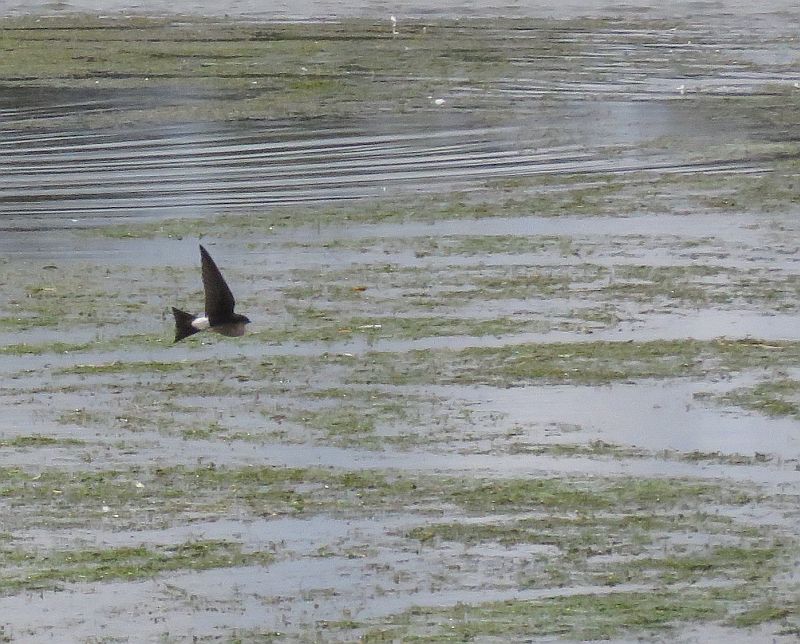 With the weather changing, Autumn migration is in full swing. In Area 10 by the Dinton Activity Centre House Martin were again feeding over Black Swan Lake and the Emm, however numbers had swelled to 300 +. . Meadow Pipit were again heading South over the car park field. Most of the breeding Meadow Pipits head south to winter in France and Iberia, with some reaching North Africa. The first returning migrants appear in February and peak passage is from mid-March to mid-April. Also seen over the car park field were Swallow and at least 1 Sand Martin . In Area 4 Paul Bright Thomas had a Hobby heading NW and 80 Meadow Pipit heading SE over his garden. In my Area 5 garden Nuthatch and Coal Tit were on the garden feders.
With the weather changing, Autumn migration is in full swing. In Area 10 by the Dinton Activity Centre House Martin were again feeding over Black Swan Lake and the Emm, however numbers had swelled to 300 +. . Meadow Pipit were again heading South over the car park field. Most of the breeding Meadow Pipits head south to winter in France and Iberia, with some reaching North Africa. The first returning migrants appear in February and peak passage is from mid-March to mid-April. Also seen over the car park field were Swallow and at least 1 Sand Martin . In Area 4 Paul Bright Thomas had a Hobby heading NW and 80 Meadow Pipit heading SE over his garden. In my Area 5 garden Nuthatch and Coal Tit were on the garden feders.
21/09/18
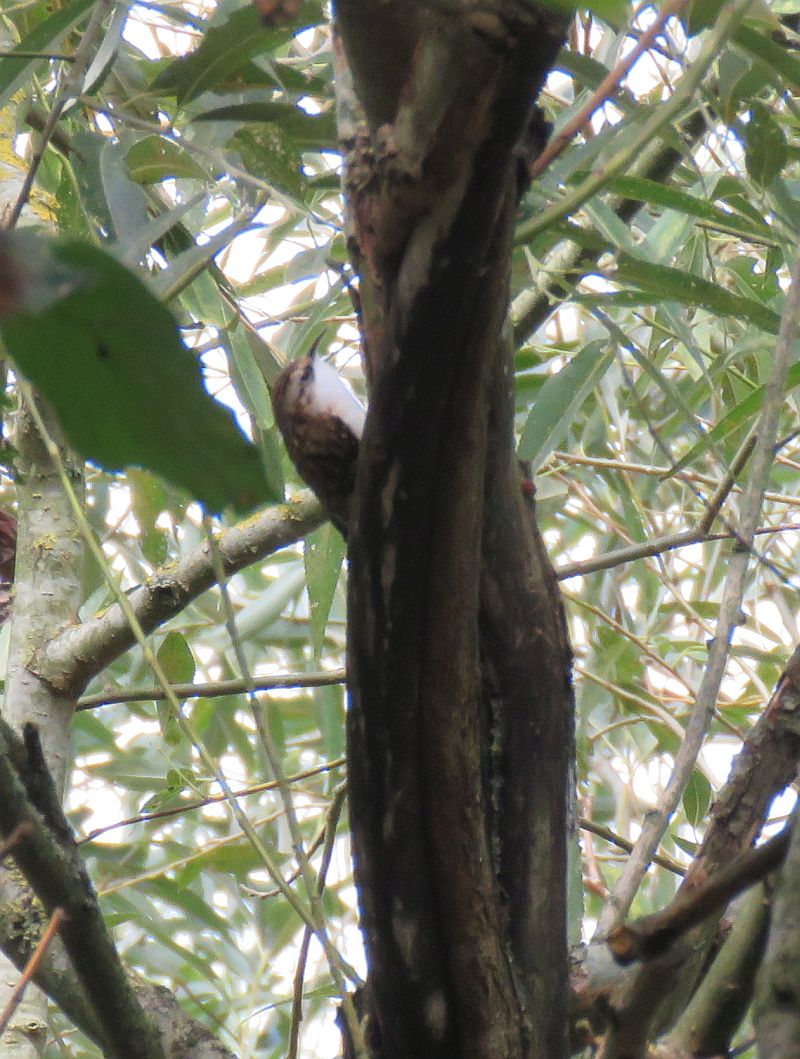 In Area 10 by the Dinton Activity Centre approx 8 House Martin were feeding over Black Swan Lake and the Emm. A Tree Creeper was seen creeping up a tree in the nearby woods . Richard Marsh was in the car park field and saw 12 Swallow , 5 Chiffchaff , 6 Blackcap and at least 50 Meadow Pipit heading South .
In Area 10 by the Dinton Activity Centre approx 8 House Martin were feeding over Black Swan Lake and the Emm. A Tree Creeper was seen creeping up a tree in the nearby woods . Richard Marsh was in the car park field and saw 12 Swallow , 5 Chiffchaff , 6 Blackcap and at least 50 Meadow Pipit heading South .
18/09/18
A Swallow was seen over the Area 10 car park field off Sandford Lane by Anne Cronin.
17/09/18
Goldcrest and Nuthatch were both seen by Nick Kightley around the Area 10 car park field off Sandford Lane.
16/09/18
During the final bout of Balsam pulling in Area 8 this morning a male Chiffchaff was calling from along the river and a Song Thrush was seen .Meanwhile approx 20 Song Thrush were seen on the west edge of the car park field in Area 10 by Fraser Cottington.
14/09/18
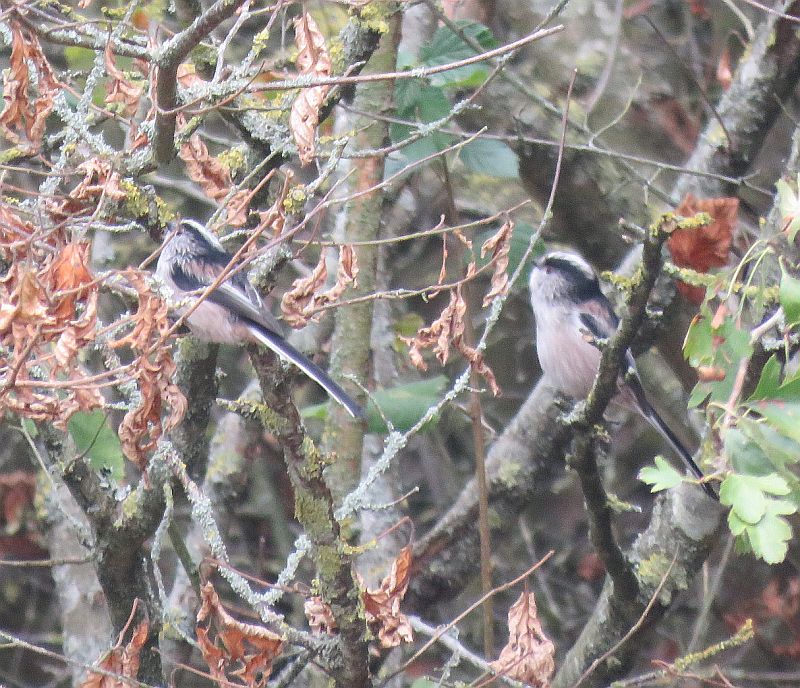 Checking the hedges and bushes around the Area 10 car park field at lunchtime paid divendends. A foraging flock containing Blue Tit , Great Tit , Long-tailed Tit , Chiffchaff and a female Blackcap were seen moving around the field edges. Also seen was a male and female Bullfinch and a Green Woodpecker .
Checking the hedges and bushes around the Area 10 car park field at lunchtime paid divendends. A foraging flock containing Blue Tit , Great Tit , Long-tailed Tit , Chiffchaff and a female Blackcap were seen moving around the field edges. Also seen was a male and female Bullfinch and a Green Woodpecker .
12/09/18
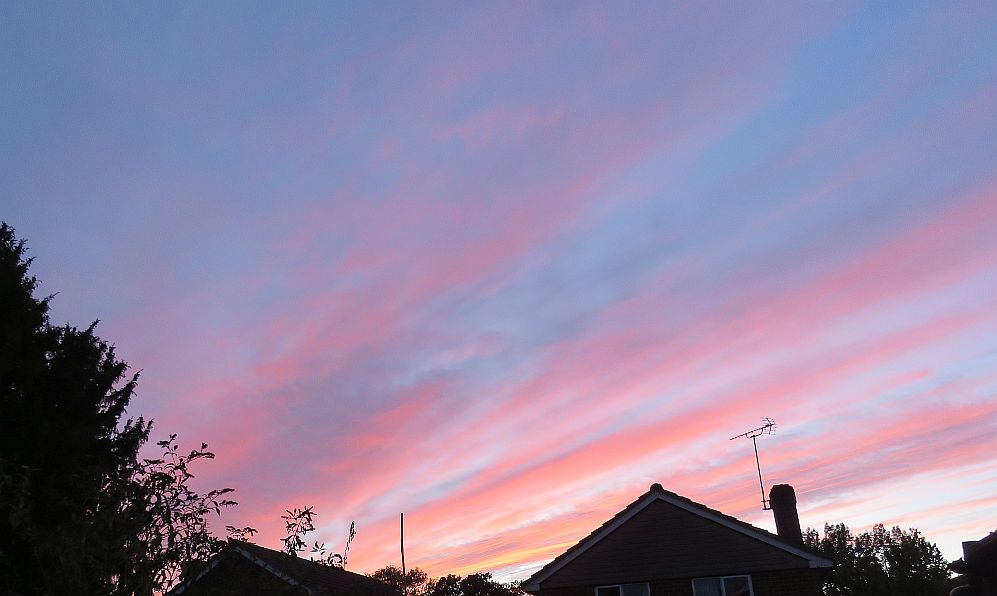 This picture is here for no other reason than it was a good sunset tonight over Area 5 . The picture doesn't really do it justice.
This picture is here for no other reason than it was a good sunset tonight over Area 5 . The picture doesn't really do it justice.
10/09/18
A Barn Owl was seen flying around the meadow in Area 10 by Fraser Cottington.
08/09/18
A pre lunch wander around Area 1 and the road to Ludgrove produced a flock of 70+ House Martin feeding over the horse fields. On the cow fields good numbers of Corvids were seen, mostly Rook with Jackdaw and Carrion Crow . 2 Ring necked Parakeet flew over calling .
07/09/18
Once again in Area 10 and a Barn Owl was seen in the box. Around the big Hawthorn in the carpark field were Whitethroat , Garden Warbler and 10+ Blackcap once again seen by Fraser Cottington.
06/09/18
In the car park field in Area 10 a Spotted Flycatcher and 6+ Blackcap were seen near the big Hawthorne tree by Fraser Cottington and Richard Marsh.
04/09/18
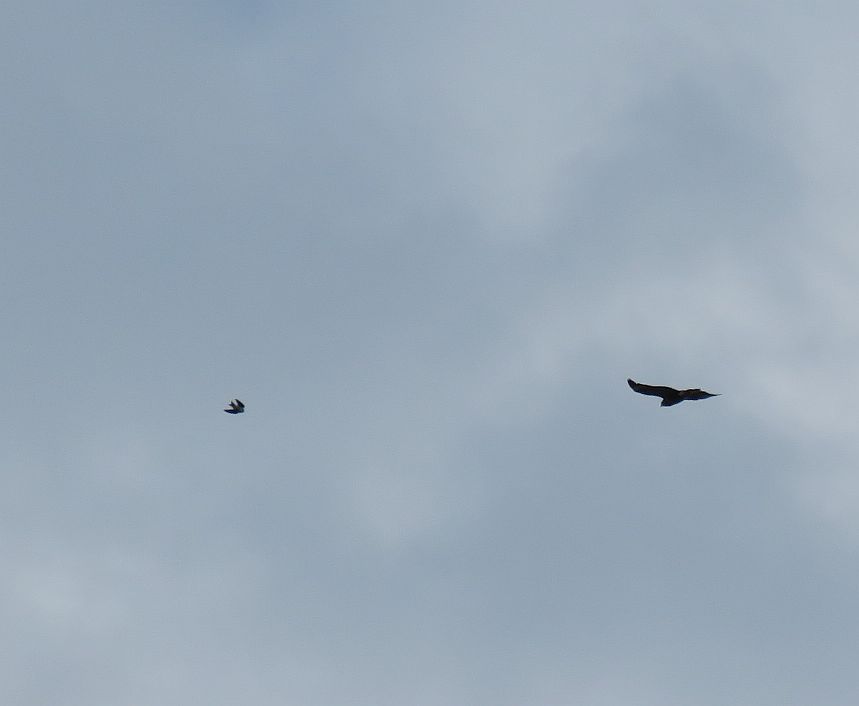 In Area 10 a Sparrowhawk was seen flying low across the car park field by Peter Scudamore/Richard Marsh. A Bullfinch , Blackcap and a party of Long tailed Tit were also seen. In Area 1 at lunchtime a Buzzard and a House Martin were seen flying over Ludgrove School.
In Area 10 a Sparrowhawk was seen flying low across the car park field by Peter Scudamore/Richard Marsh. A Bullfinch , Blackcap and a party of Long tailed Tit were also seen. In Area 1 at lunchtime a Buzzard and a House Martin were seen flying over Ludgrove School.
02/09/18
With 8 Goldfinch on the feeders in my Area 5 garden, and all the spaces occupied, they were waiting in the trees for a space. I must devise a "Fly Thru" service . Along the river in Area 5 heard at lunchtime were Green Woodpecker , Nuthatch , Great spotted Woodpecker and an alarm calling male Blackcap .
|
Insects
27/09/18
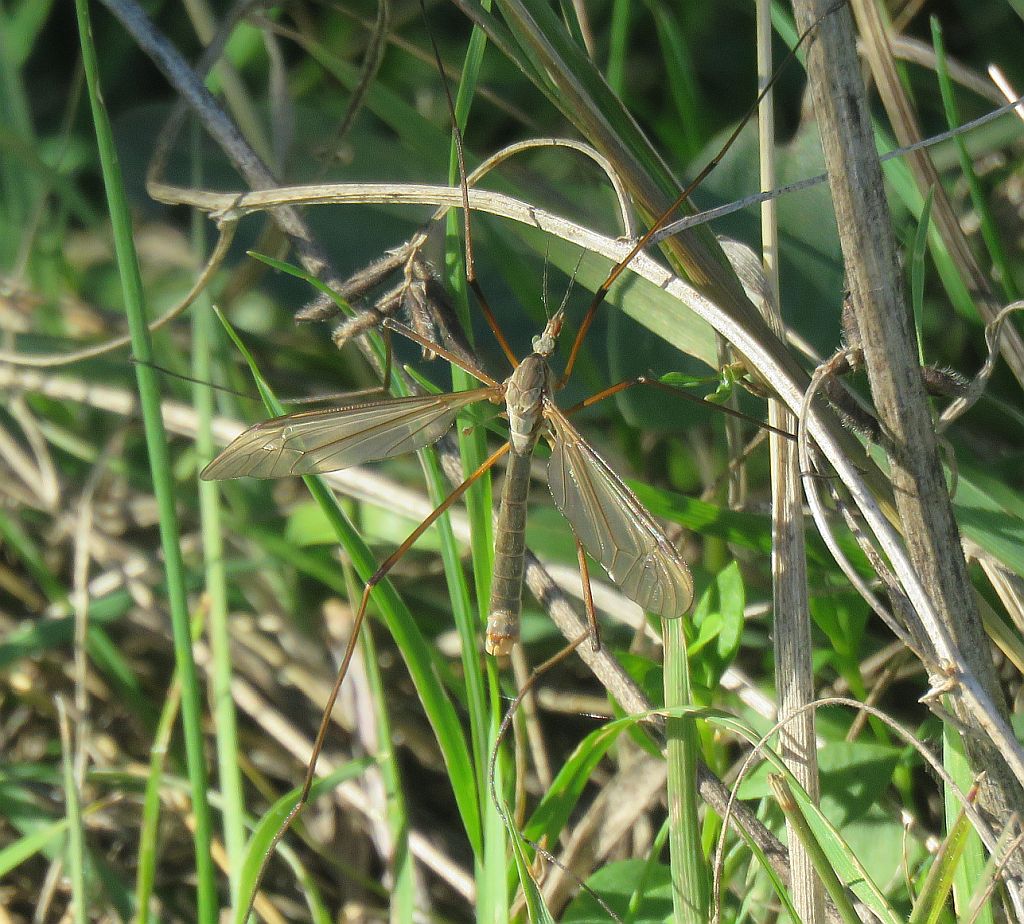 Despite being very common at this time of the year, I managed to get my first good views of a male Cranefly Tipula oleracea this Autumn in the Area 10 car park field. This is possibly our most common cranefly with a brown front edge and a brown stigma to its wings. It also tends to be seen earlier in the year. As with all craneflies, the females, prior to egg laying will be plump (they can carry several hundred eggs) and have pointed abdomens - all the better to insert eggs into damp soil. The males tend to be slim with squared off or club shaped abdomens.
Despite being very common at this time of the year, I managed to get my first good views of a male Cranefly Tipula oleracea this Autumn in the Area 10 car park field. This is possibly our most common cranefly with a brown front edge and a brown stigma to its wings. It also tends to be seen earlier in the year. As with all craneflies, the females, prior to egg laying will be plump (they can carry several hundred eggs) and have pointed abdomens - all the better to insert eggs into damp soil. The males tend to be slim with squared off or club shaped abdomens.  . A male Migrant Hawker Aeshna mixta Dragonfly was also seen along with a male Common Darter Sympetrum striolatum . . A male Migrant Hawker Aeshna mixta Dragonfly was also seen along with a male Common Darter Sympetrum striolatum .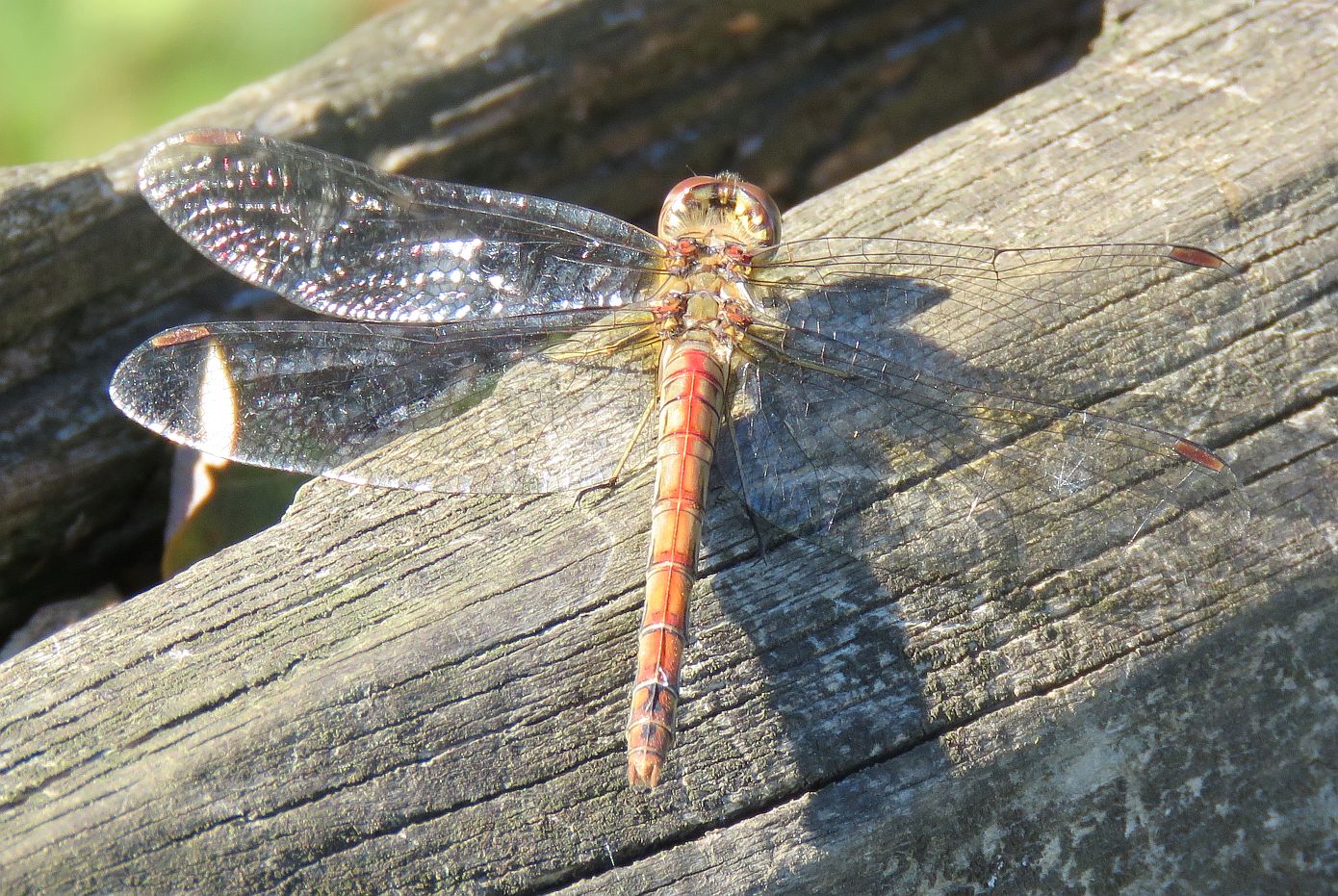 This is one of the smaller dragonflies. The male is orange-red but becoming brown with age. Females (and juvenile males) are yellowish to light brown.A Small Copper Lycaena phlaeas Butterfly was on the wing, along with a Speckled Wood Meconema thalassinum . This is one of the smaller dragonflies. The male is orange-red but becoming brown with age. Females (and juvenile males) are yellowish to light brown.A Small Copper Lycaena phlaeas Butterfly was on the wing, along with a Speckled Wood Meconema thalassinum .
21/09/18
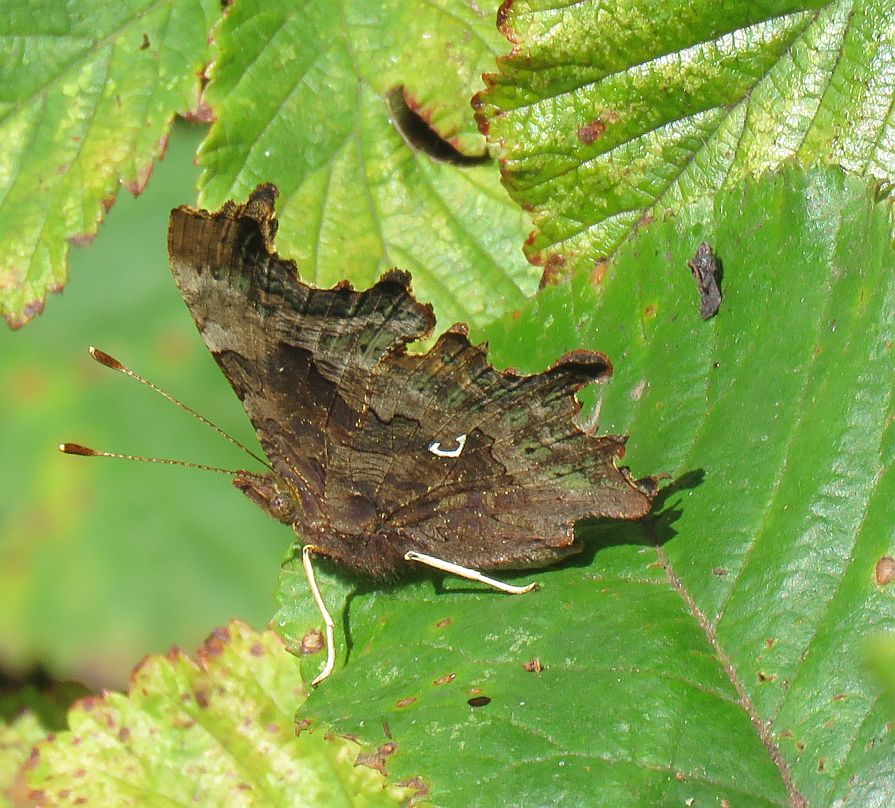 On the Bramble bush in the Area 10 car park field today were Butterflies of Comma Hedera helix , (this underwing photo shows the white markings from which it gets it name ) Red Admiral Meconema thalassinum and Speckled Wood Meconema thalassinum .
On the Bramble bush in the Area 10 car park field today were Butterflies of Comma Hedera helix , (this underwing photo shows the white markings from which it gets it name ) Red Admiral Meconema thalassinum and Speckled Wood Meconema thalassinum .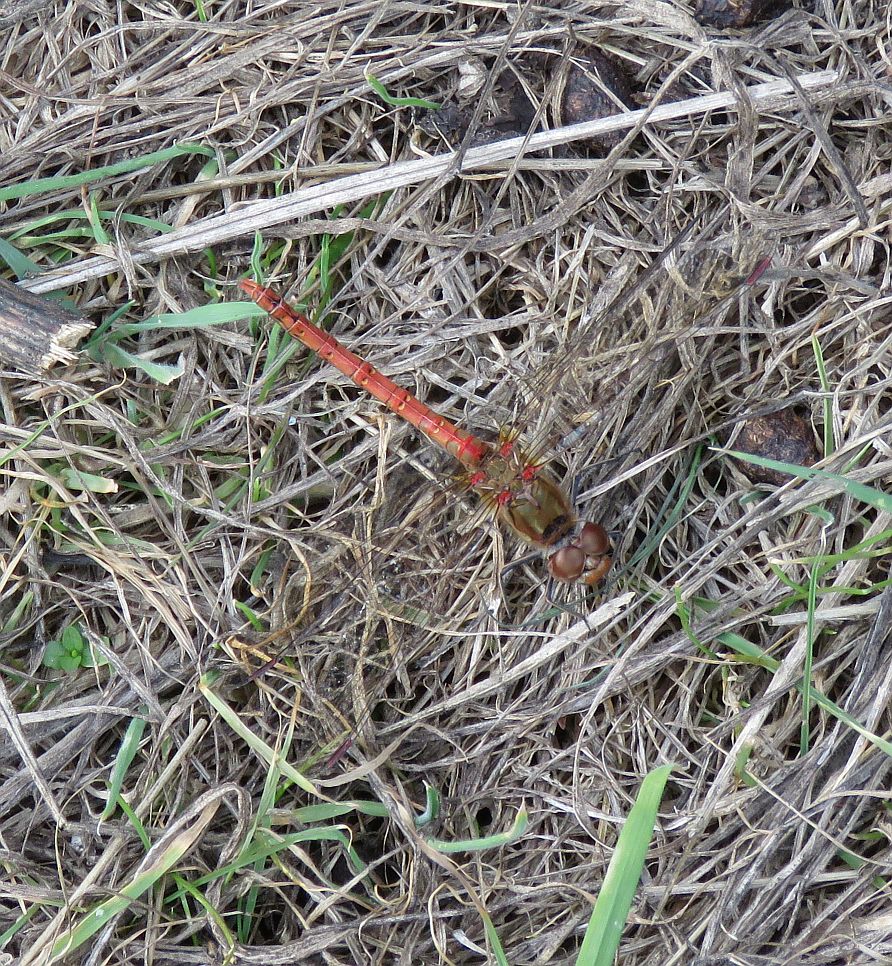 A Large Red Damselfly Pyrrhosoma nymphula was sunning itself on the floor with 2 Migrant Hawker Aeshna mixta and a Common Darter Sympetrum striolatum Dragonfly resting on the Bramble bush. A Large Red Damselfly Pyrrhosoma nymphula was sunning itself on the floor with 2 Migrant Hawker Aeshna mixta and a Common Darter Sympetrum striolatum Dragonfly resting on the Bramble bush.
20/09/18
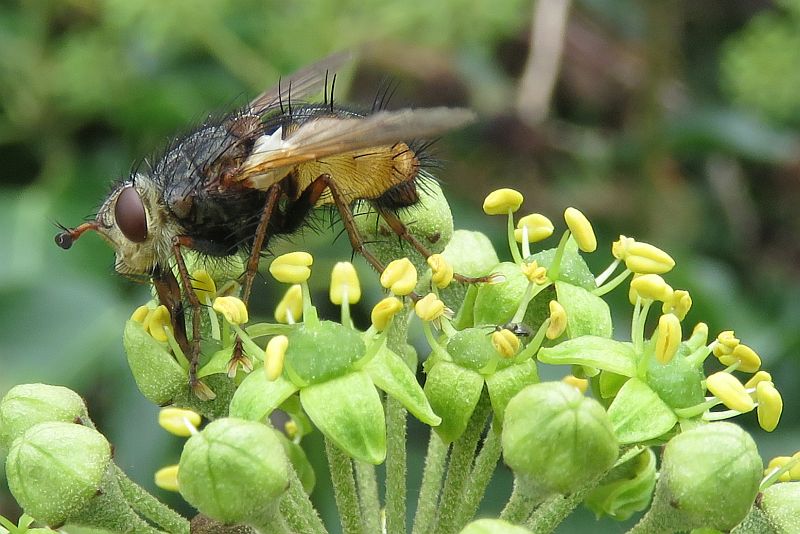 On a windy afternoon in Area 5 courtesy of Storm Bronagh, the only activity was around the pollen of the Ivy Hedera helix . Seen feeding on the pollen were, the fly Tachina fera , Common Wasp Vespula vulgaris,
On a windy afternoon in Area 5 courtesy of Storm Bronagh, the only activity was around the pollen of the Ivy Hedera helix . Seen feeding on the pollen were, the fly Tachina fera , Common Wasp Vespula vulgaris, 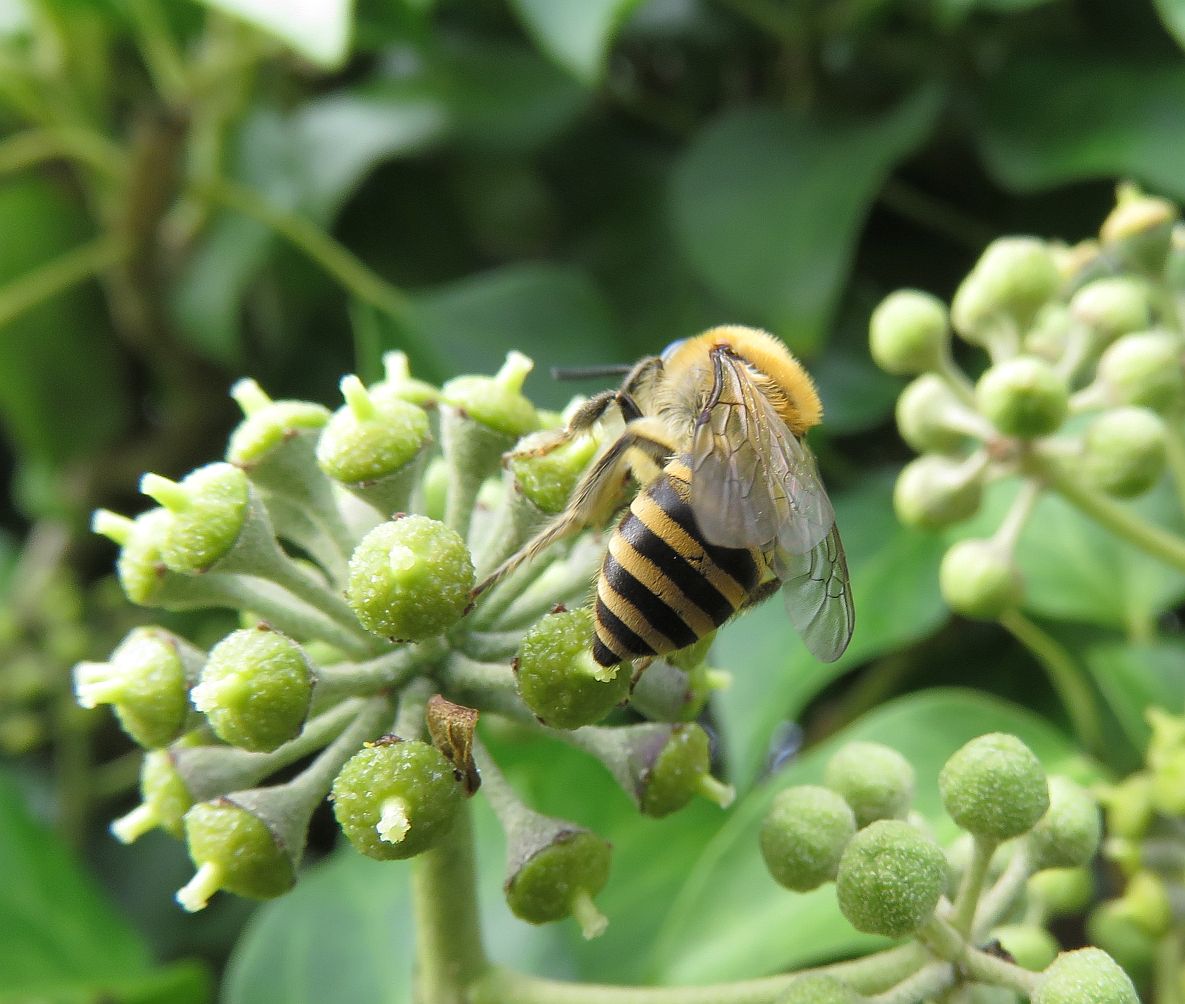 several Ivy Bee Colletes hederae a relative newcomer to the UK, a Drone Fly Eristalis arbustorum , the Hoverfly Helophilus pendulus and the Red-legged Shieldbug Pentatoma rufipes . several Ivy Bee Colletes hederae a relative newcomer to the UK, a Drone Fly Eristalis arbustorum , the Hoverfly Helophilus pendulus and the Red-legged Shieldbug Pentatoma rufipes .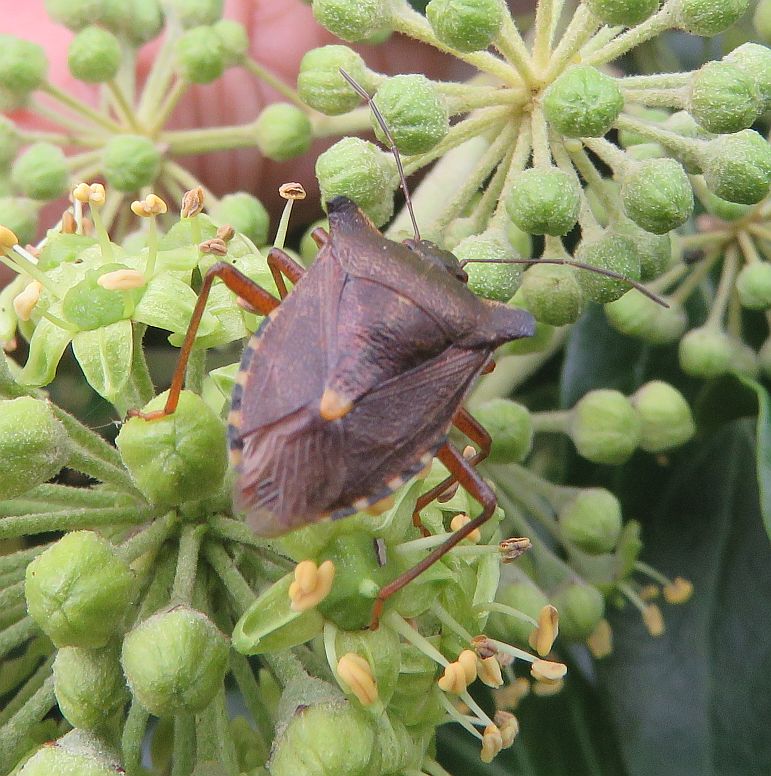 Also known as Forest Bug, they can be distinguished from other shieldbugs by their square shoulders. They look like they're wearing American football player padding. Also known as Forest Bug, they can be distinguished from other shieldbugs by their square shoulders. They look like they're wearing American football player padding.
17/09/18
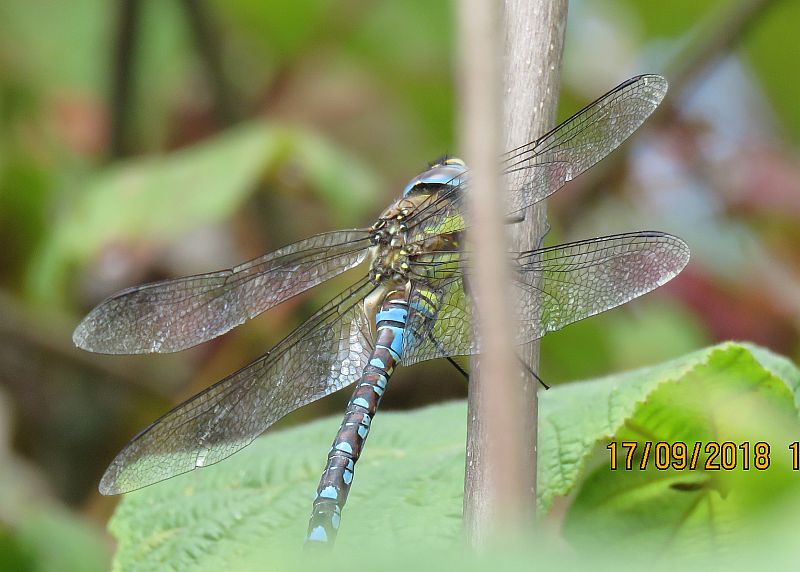 Lunchtime in Area 10 and with the sunshine it proved to be a good day for Dragon and Damselflies. Odanata on the wing were Common Blue Damselfly Enallagma cyathigerum ,a male Migrant Hawker Aeshna mixta Dragonfly and another Dragonfly a Common Darter Sympetrum striolatum . Thanks to Mike Turton the County Dragonfly recorder for help with id . 2 Hornet Vespa crabro were aso seen
Lunchtime in Area 10 and with the sunshine it proved to be a good day for Dragon and Damselflies. Odanata on the wing were Common Blue Damselfly Enallagma cyathigerum ,a male Migrant Hawker Aeshna mixta Dragonfly and another Dragonfly a Common Darter Sympetrum striolatum . Thanks to Mike Turton the County Dragonfly recorder for help with id . 2 Hornet Vespa crabro were aso seen 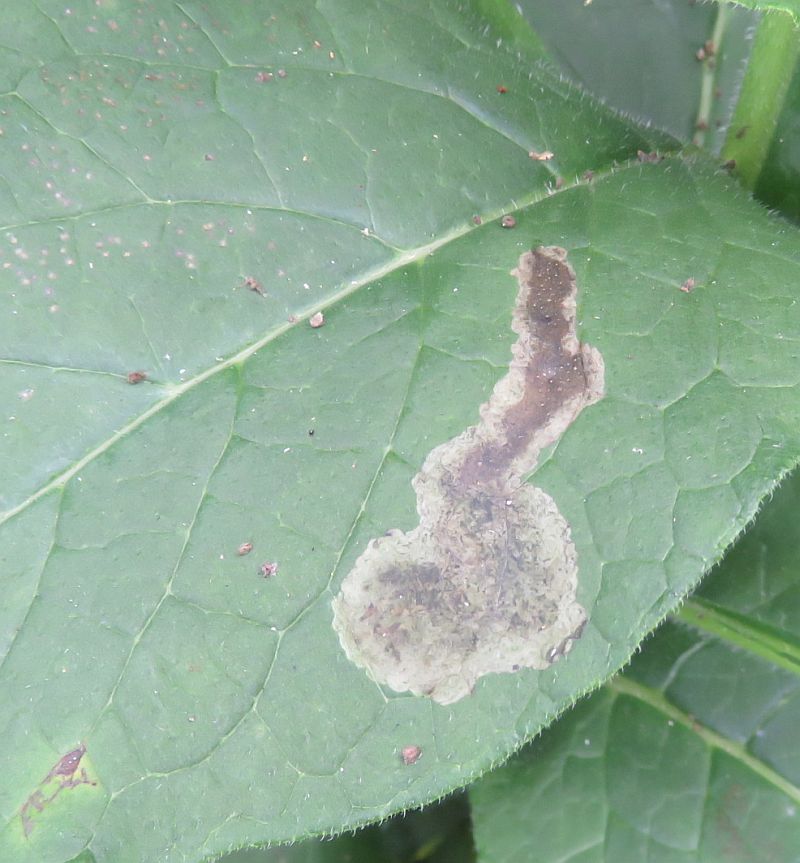 as was the leaf mine of Agromyza abiens on a Comfrey leaf.The main butterfly on the wing at present is Speckled Wood Meconema thalassinum and they are very abundant this year, they are one of the few species that you can see throughout the season as they have a series of overlapping broods. Sometimes the first are on the wing before the end of March and they can still be flying in November. A Red Admiral Meconema thalassinum was seen again on the Blackberries. as was the leaf mine of Agromyza abiens on a Comfrey leaf.The main butterfly on the wing at present is Speckled Wood Meconema thalassinum and they are very abundant this year, they are one of the few species that you can see throughout the season as they have a series of overlapping broods. Sometimes the first are on the wing before the end of March and they can still be flying in November. A Red Admiral Meconema thalassinum was seen again on the Blackberries.
16/09/18
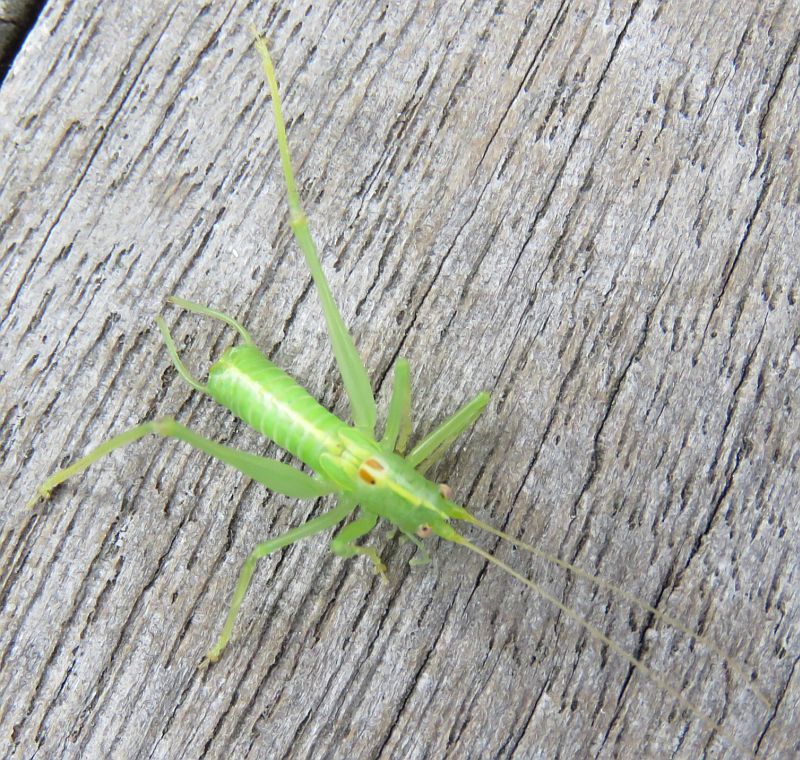 Mowing the lawn in Area 5 and found a male Oak Bush-cricket Meconema thalassinum . The Oak Bush-cricket is not often seen, but does fly well and is attracted to lights at night, so occasionally turns up in moth traps or on windows. It is carnivorous and feeds on smaller invertebrates. It does not have a 'song' as such, but drums on leaves with its hind legs. The female lays her eggs in tree bark in late summer and the nymphs emerge the following June.Female bush-crickets can be distinguished from their male counterparts by their long, curved ovipositors, visible at the end of the body. Males have two short, rounded claspers.
Mowing the lawn in Area 5 and found a male Oak Bush-cricket Meconema thalassinum . The Oak Bush-cricket is not often seen, but does fly well and is attracted to lights at night, so occasionally turns up in moth traps or on windows. It is carnivorous and feeds on smaller invertebrates. It does not have a 'song' as such, but drums on leaves with its hind legs. The female lays her eggs in tree bark in late summer and the nymphs emerge the following June.Female bush-crickets can be distinguished from their male counterparts by their long, curved ovipositors, visible at the end of the body. Males have two short, rounded claspers.
14/09/18
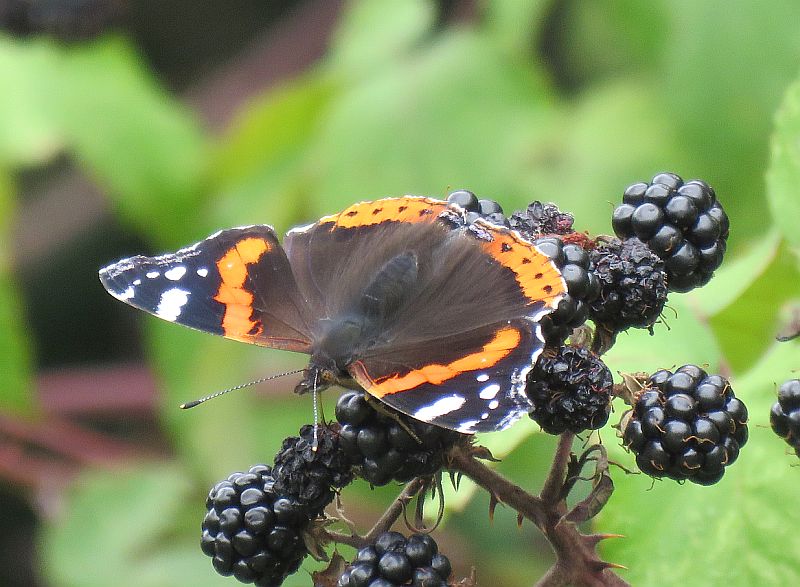 With one not seen for a long time, it was nice to find a Red Admiral Meconema thalassinum butterfly
With one not seen for a long time, it was nice to find a Red Admiral Meconema thalassinum butterfly
12/09/18
What I believe to be a Turnip Moth Agrotis segetum was found inside my Area 5 house. Photo to follow.
10/09/18
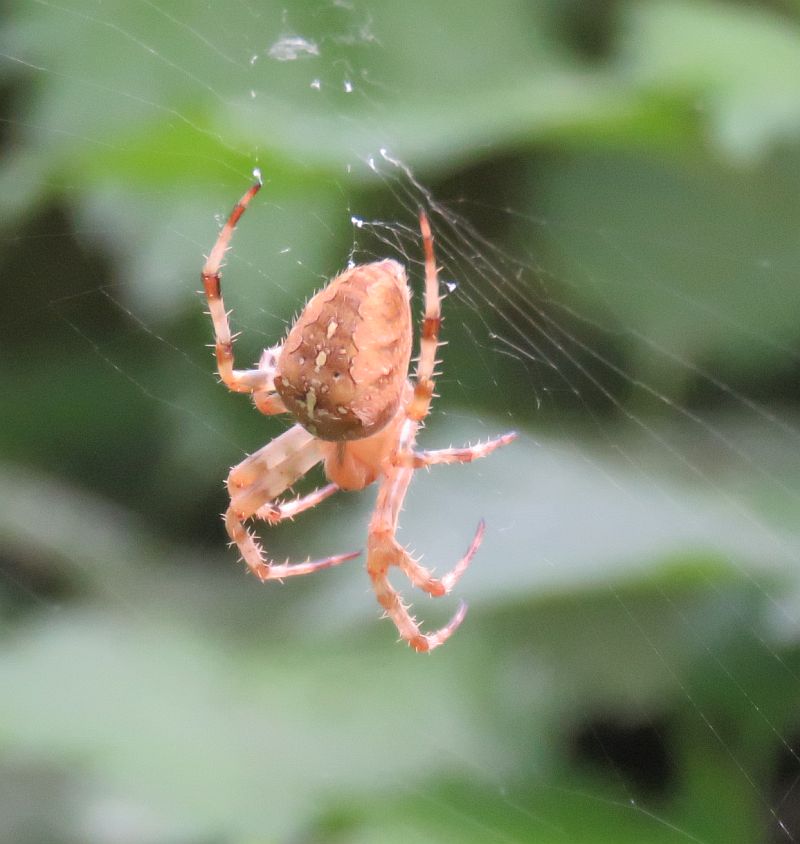 Not an Insect, I know but still a nice looking beast.In Area 10 a Garden Spider Araneus diadematus was patiently waiting on its web for lunch. At this time of the year Spiders web become more visible especially with the early morning dew. The Garden Spider is easy to identify due to its cruciform white markings on its abdomen.
Not an Insect, I know but still a nice looking beast.In Area 10 a Garden Spider Araneus diadematus was patiently waiting on its web for lunch. At this time of the year Spiders web become more visible especially with the early morning dew. The Garden Spider is easy to identify due to its cruciform white markings on its abdomen.
05/09/18
 On my kitchen wall this morning was a male Orange Swift Hepialus sylvina moth. No doubt lured in by a combination of a light and an open window.
The males are more brightly coloured and smaller than the females, with a distinctive bright orange-brown forewing and two dark-edged white lines forming an open V. The females are a duller brown. When at rest they hold their elongated wings almost vertically against their body.
The adults have short antennae and have no functioning mouthparts so cannot feed.
On my kitchen wall this morning was a male Orange Swift Hepialus sylvina moth. No doubt lured in by a combination of a light and an open window.
The males are more brightly coloured and smaller than the females, with a distinctive bright orange-brown forewing and two dark-edged white lines forming an open V. The females are a duller brown. When at rest they hold their elongated wings almost vertically against their body.
The adults have short antennae and have no functioning mouthparts so cannot feed.
 In Area 10 and living up to its name,is the gall Robin's Pincushion Dipoloepis rosae . It is a red, round, hairy growth that can be seen on wild roses. It is caused by the larvae of a tiny gall wasp that feeds on the host plant, but causes little damage.The gall is widespread and common, and can be found developing on the stems of Dog-roses during late summer; it acquires its reddish colour as it matures in autumn. Each gall holds many grubs, which feed on the gall tissues throughout the winter and emerge in spring as adults.
In Area 10 and living up to its name,is the gall Robin's Pincushion Dipoloepis rosae . It is a red, round, hairy growth that can be seen on wild roses. It is caused by the larvae of a tiny gall wasp that feeds on the host plant, but causes little damage.The gall is widespread and common, and can be found developing on the stems of Dog-roses during late summer; it acquires its reddish colour as it matures in autumn. Each gall holds many grubs, which feed on the gall tissues throughout the winter and emerge in spring as adults.
04/09/18
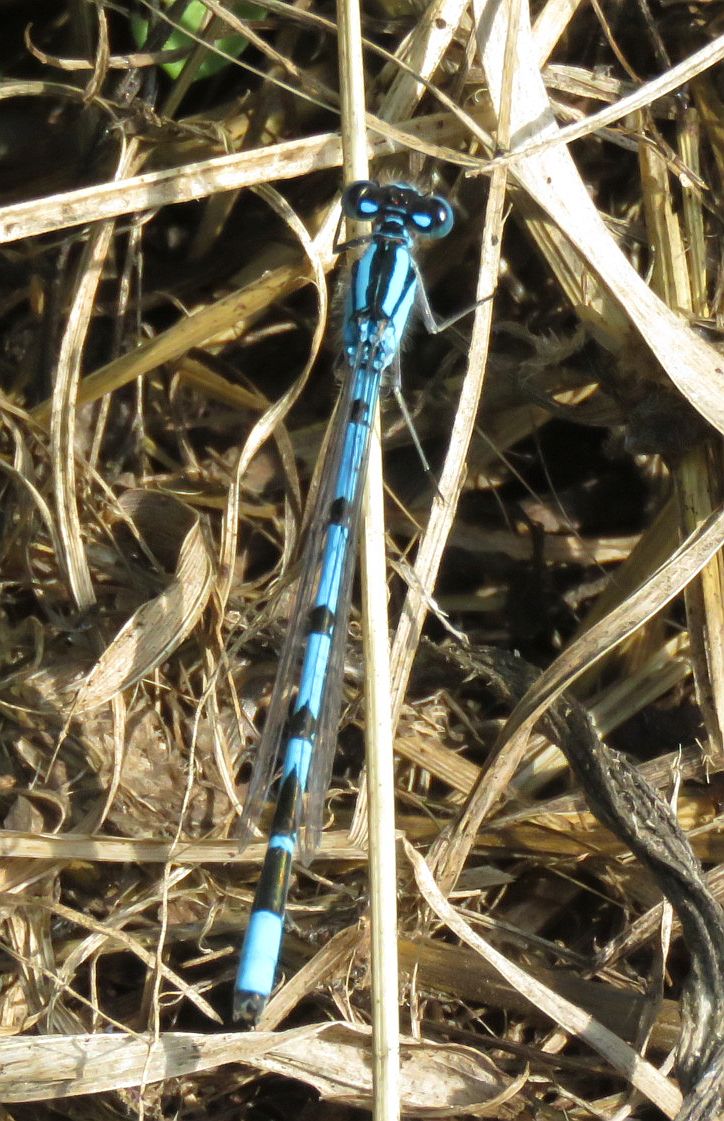 Still on the wing, although resting in this picture in Area 10 were Common Blue Damselfly Enallagma cyathigerum .
Still on the wing, although resting in this picture in Area 10 were Common Blue Damselfly Enallagma cyathigerum .
02/09/18
 On the Umbellifers down by the Area 5 pond was a Myathropa florea Hoverfly. Also seen was Crimson-banded Hoverfly Brachypalpoides lentus
A very attractive hoverfly with a deep crimson band occupying most of the abdomen. It is a flash of this colour moving through undergrowth or around the bases of old trees that tends to first alert you to its presence. Again this was on the Umbellifers.
On the Umbellifers down by the Area 5 pond was a Myathropa florea Hoverfly. Also seen was Crimson-banded Hoverfly Brachypalpoides lentus
A very attractive hoverfly with a deep crimson band occupying most of the abdomen. It is a flash of this colour moving through undergrowth or around the bases of old trees that tends to first alert you to its presence. Again this was on the Umbellifers.
01/09/18
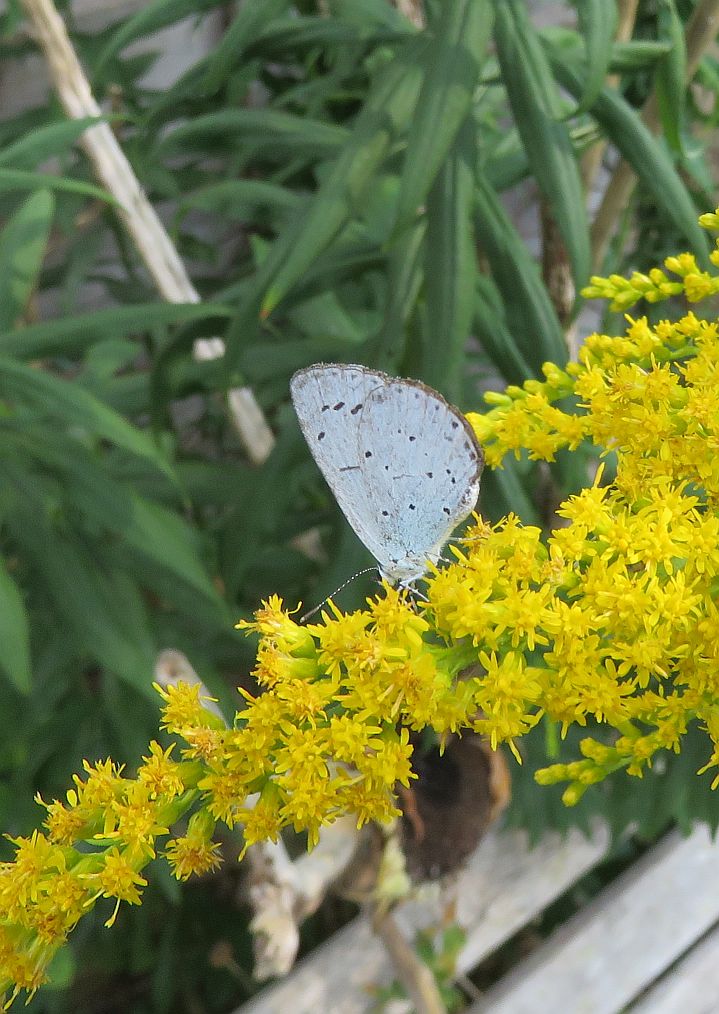 In the sunshine on the Goldon Rod in my Area 5 garden was Holly Blue Celastrina argiolus . and Large White Pieris brassicae butterflies.
In the sunshine on the Goldon Rod in my Area 5 garden was Holly Blue Celastrina argiolus . and Large White Pieris brassicae butterflies.
|
Plant/Trees
24/09/18
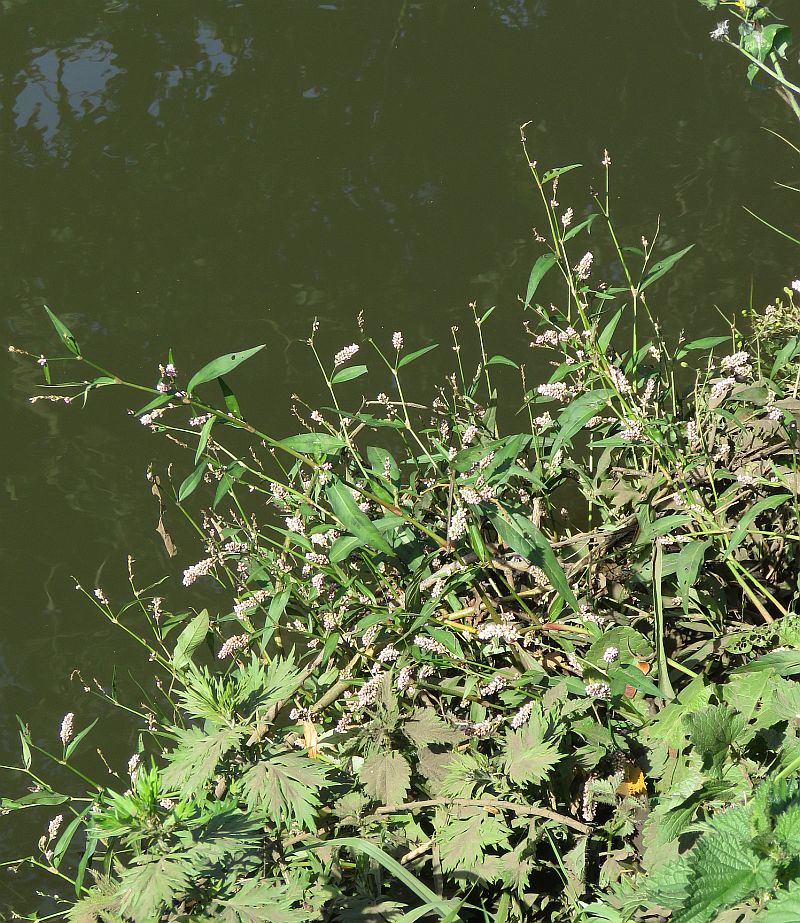 On the banks of the Emm Brook in Area 10 Redshank Persicaria maculosa can be seen.This is a very common weed which is found in wet places, fields and waste ground. A late summer flowerer.
On the banks of the Emm Brook in Area 10 Redshank Persicaria maculosa can be seen.This is a very common weed which is found in wet places, fields and waste ground. A late summer flowerer.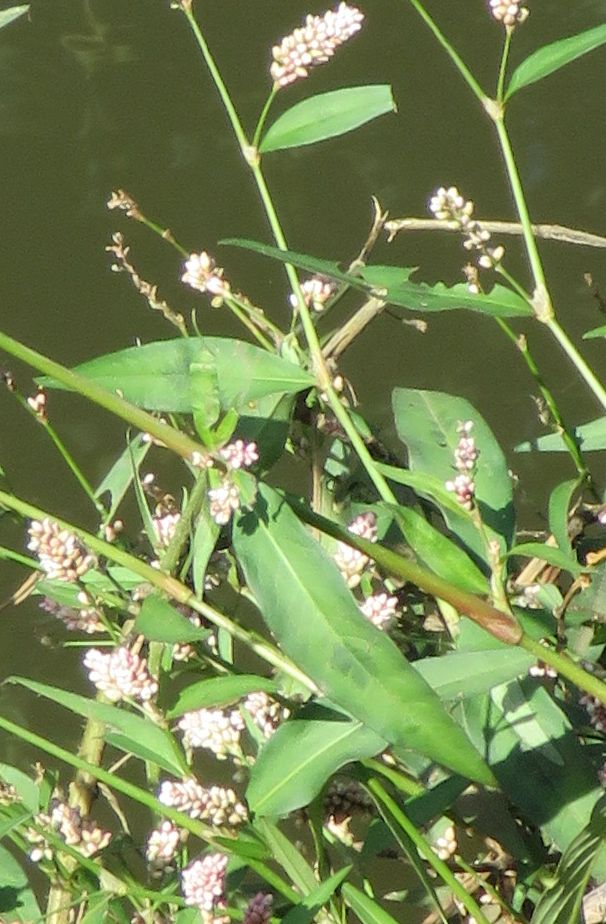 The spots on the leaves (hence maculosa) are said in one tale to have come from drops of Jesus' blood which fell on the plant under the cross. The spots on the leaves (hence maculosa) are said in one tale to have come from drops of Jesus' blood which fell on the plant under the cross.
20/09/18
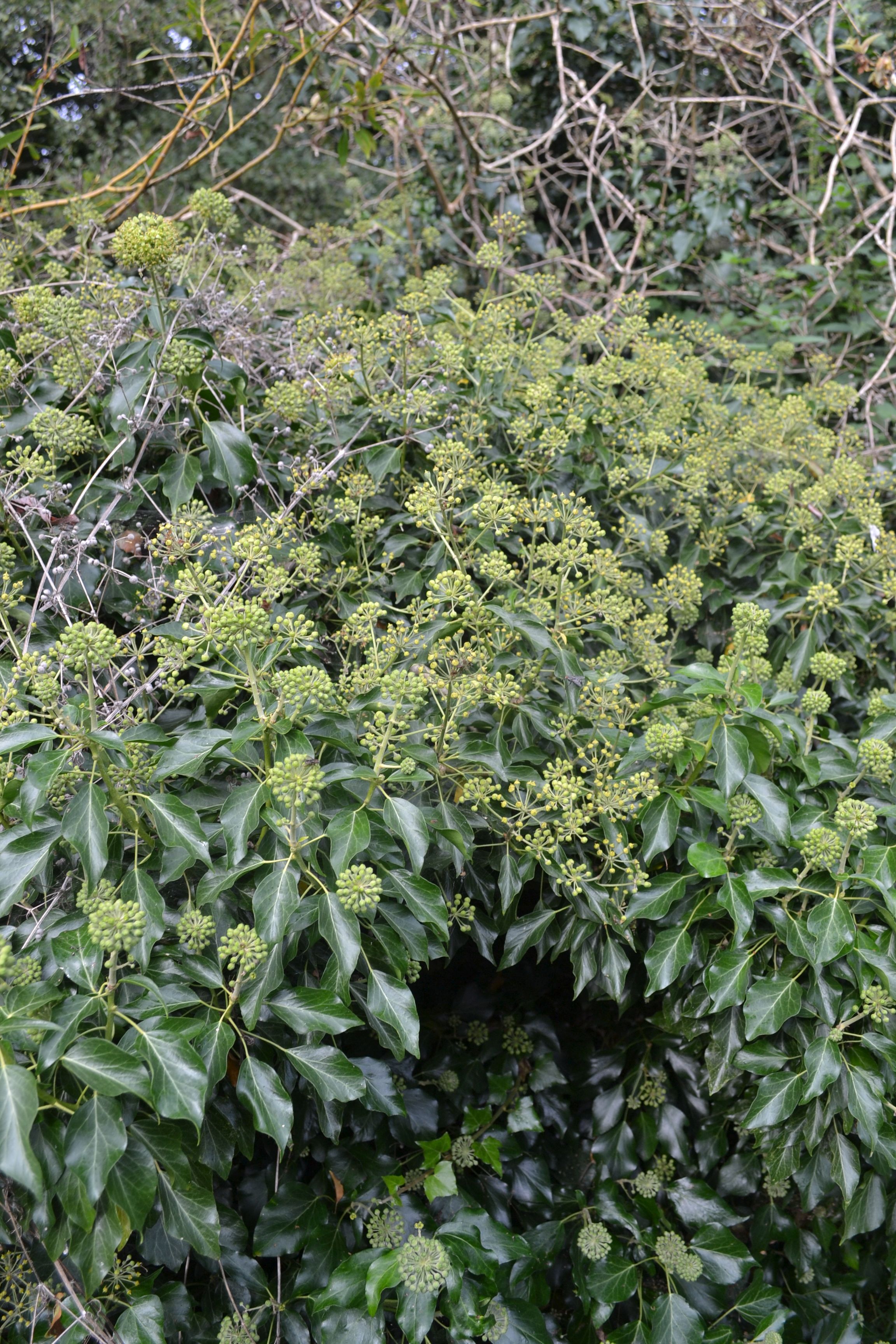 Ivy Hedera helix is a undervalued resource. It can be seen in flower along the Emm at this time of year.
Nectar, pollen and berries of Ivy are an essential food source for insects and birds during autumn and winter when food is scarce. It also provides shelter for insects, birds, bats and other small mammals. The high fat content of the berries is a nutritious food resource for birds and they are eaten by a range of species including Thrushes, Blackcaps, Woodpigeons and Blackbirds.
Ivy Hedera helix is a undervalued resource. It can be seen in flower along the Emm at this time of year.
Nectar, pollen and berries of Ivy are an essential food source for insects and birds during autumn and winter when food is scarce. It also provides shelter for insects, birds, bats and other small mammals. The high fat content of the berries is a nutritious food resource for birds and they are eaten by a range of species including Thrushes, Blackcaps, Woodpigeons and Blackbirds.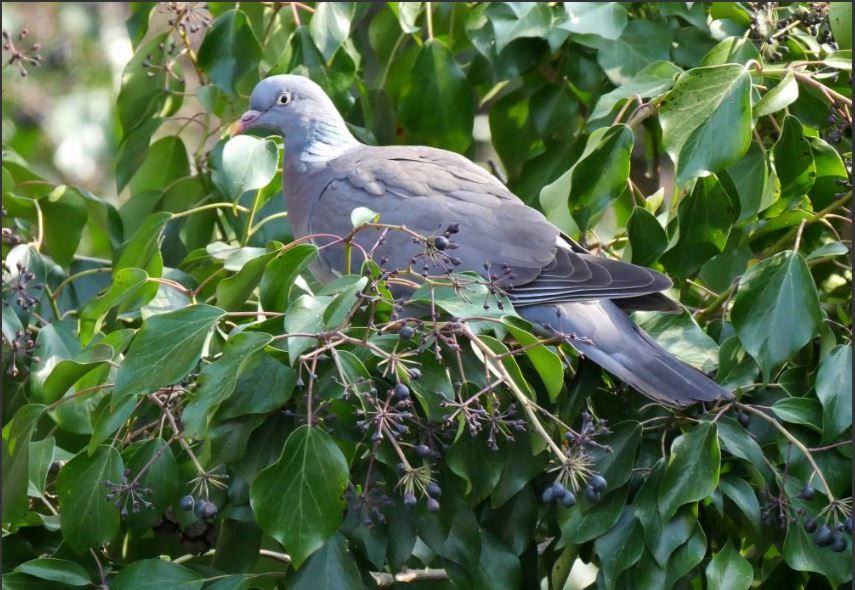 Ivy provides essential food to many insects before they go into hibernation. Some of the main insect species which forage on the nectar and pollen of ivy are bees, hoverflies and common wasps.
As an evergreen species both ivy and holly were seen as especially powerful symbols during winter, and sprigs were brought into houses to keep evil spirits at bay.
Wearing a wreath of ivy leaves around the head is supposed to prevent one from getting drunk. The Roman god Bacchus, the god of intoxication, was often depicted wearing a wreath of ivy and grapevines.
Ivy was seen as a symbol of intellectual achievement in ancient Rome and wreaths were used to crown winners of poetry contests.
Wreaths were also given to winning athletes in ancient Greece. Contary to popular belief Ivy is not parasitic and just uses trees to climb. Ivy uses trees and walls for support, allowing it to reach upwards to better levels of sunlight. It has a separate root system in the soil and so absorbs its own nutrients and water as needed.Ivy does not damage trees and its presence doesn’t indicate that a tree is unhealthy.
Ivy provides essential food to many insects before they go into hibernation. Some of the main insect species which forage on the nectar and pollen of ivy are bees, hoverflies and common wasps.
As an evergreen species both ivy and holly were seen as especially powerful symbols during winter, and sprigs were brought into houses to keep evil spirits at bay.
Wearing a wreath of ivy leaves around the head is supposed to prevent one from getting drunk. The Roman god Bacchus, the god of intoxication, was often depicted wearing a wreath of ivy and grapevines.
Ivy was seen as a symbol of intellectual achievement in ancient Rome and wreaths were used to crown winners of poetry contests.
Wreaths were also given to winning athletes in ancient Greece. Contary to popular belief Ivy is not parasitic and just uses trees to climb. Ivy uses trees and walls for support, allowing it to reach upwards to better levels of sunlight. It has a separate root system in the soil and so absorbs its own nutrients and water as needed.Ivy does not damage trees and its presence doesn’t indicate that a tree is unhealthy.
16/09/18
 In Area 8 at Old Forest Road Meadows is a patch of Common Toadflax Linaria vulgaris .Common Toadflax is a common plant of waste ground, grassland, roadside verges and hedgerows. Its yellow-and-orange flowers appear in June and persist well into November; they look like the flowers of snapdragons (familiar garden plants), and are often densely packed. These flowers give the plant its other common name of 'Butter and Eggs'.Also seen were Ragwort Jacobaea vulgaris , Ribwort Plantain Plantago lanceolata , White Dead- Nettle Lamium album, and Common Knapweed Centaurea nigra .
In Area 8 at Old Forest Road Meadows is a patch of Common Toadflax Linaria vulgaris .Common Toadflax is a common plant of waste ground, grassland, roadside verges and hedgerows. Its yellow-and-orange flowers appear in June and persist well into November; they look like the flowers of snapdragons (familiar garden plants), and are often densely packed. These flowers give the plant its other common name of 'Butter and Eggs'.Also seen were Ragwort Jacobaea vulgaris , Ribwort Plantain Plantago lanceolata , White Dead- Nettle Lamium album, and Common Knapweed Centaurea nigra .
05/09/18
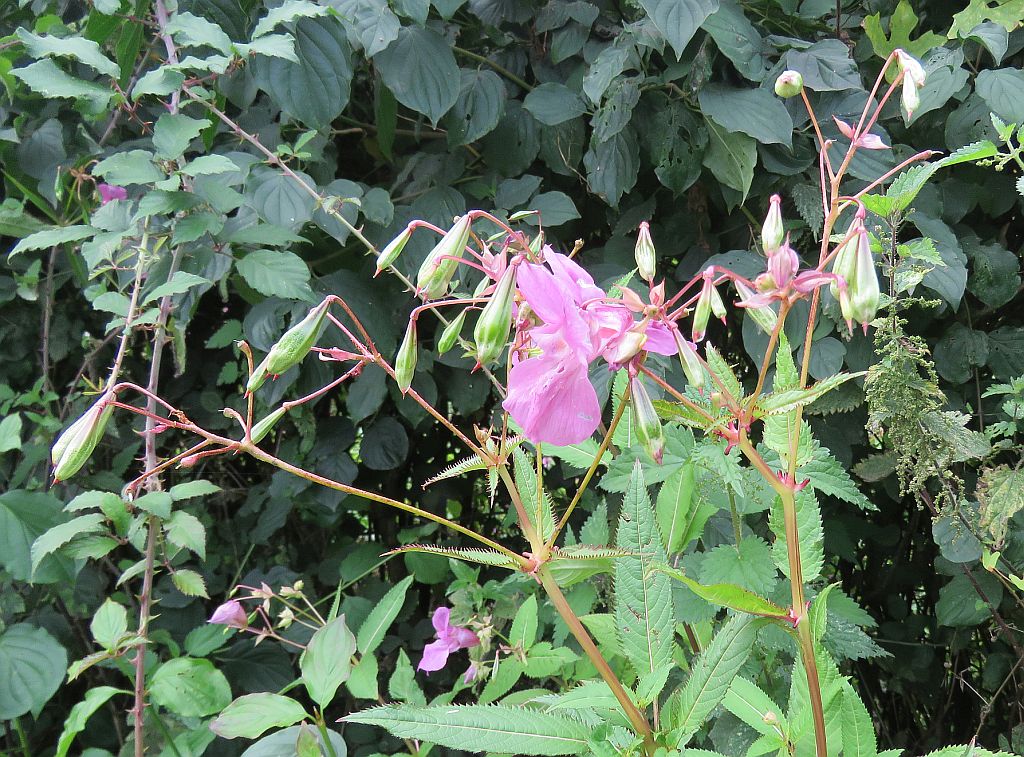 Away from the river in Area 10 Himalayan Balsam Impatiens glandulifera is in flower and already going to seed. The seed pods open explosively when ripe.Each plant can produce up to 800 seeds. These are dispersed widely as the ripe seedpods shoot their seeds up to 7m (22ft) away.Introduced to the UK in 1839, Himalayan balsam is now a naturalised plant. Himalayan balsam tolerates low light levels and also shades out other vegetation, so gradually impoverishing habitats by killing off other plants.
Away from the river in Area 10 Himalayan Balsam Impatiens glandulifera is in flower and already going to seed. The seed pods open explosively when ripe.Each plant can produce up to 800 seeds. These are dispersed widely as the ripe seedpods shoot their seeds up to 7m (22ft) away.Introduced to the UK in 1839, Himalayan balsam is now a naturalised plant. Himalayan balsam tolerates low light levels and also shades out other vegetation, so gradually impoverishing habitats by killing off other plants.
 In Area 8 at Old Forest Meadows was a Bristly Oxtongue Helminthotheca echioides.
At first glance this might look like another of those hard to identify dandelion 'look-a-likes' but actually it is really easy to pick out because its leaves are prickly (a bit like a thistle) but the main feature is the presence of 'bumps', or pimples ,all over the leaves, they look a bit like galls. This is a difficult to describe and illustrate feature but once you find the plant you will know what I mean, it is like no other. The flower head turns in to the classic dandelion clock when it is over and the same plant produces many stems each with flowers at various stages in the cycle. You will find new buds, full flowers and seed heads all on the same plant.
A scruffy plant yes, but these yellow complex flower heads are quite delightful and are a prime nectar source for insects late in the year, particularly for bees and hoverflies.
In Area 8 at Old Forest Meadows was a Bristly Oxtongue Helminthotheca echioides.
At first glance this might look like another of those hard to identify dandelion 'look-a-likes' but actually it is really easy to pick out because its leaves are prickly (a bit like a thistle) but the main feature is the presence of 'bumps', or pimples ,all over the leaves, they look a bit like galls. This is a difficult to describe and illustrate feature but once you find the plant you will know what I mean, it is like no other. The flower head turns in to the classic dandelion clock when it is over and the same plant produces many stems each with flowers at various stages in the cycle. You will find new buds, full flowers and seed heads all on the same plant.
A scruffy plant yes, but these yellow complex flower heads are quite delightful and are a prime nectar source for insects late in the year, particularly for bees and hoverflies.
02/09/18
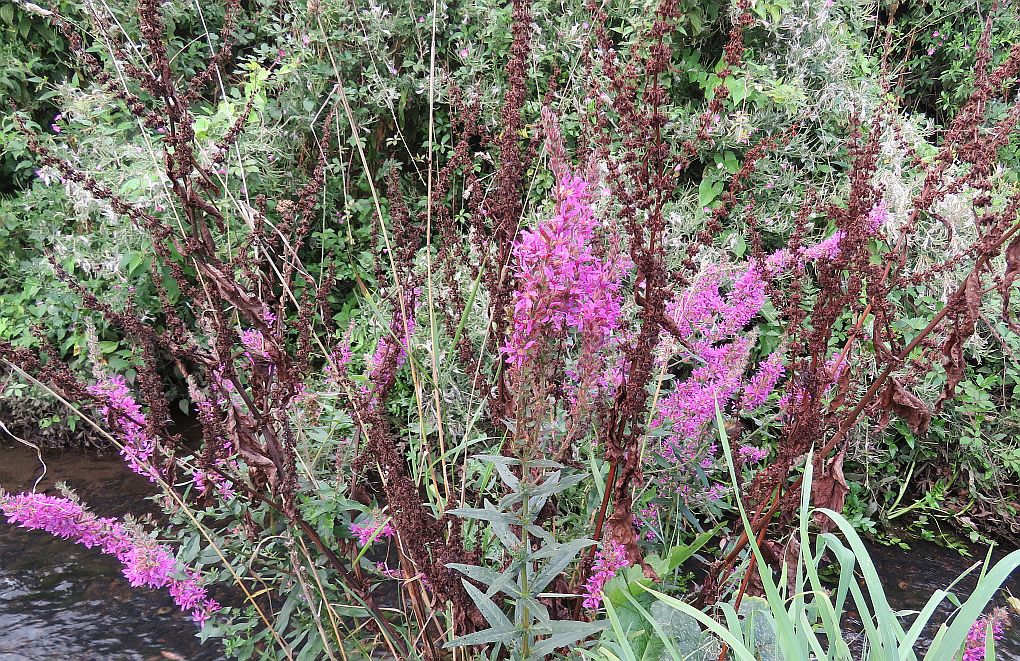 Still in bloom along the river is Purple Loosestrife Lythrum salicaria .
Still in bloom along the river is Purple Loosestrife Lythrum salicaria .
Other Wildlife
Amphibians and Reptiles
Mammals
27/09/18
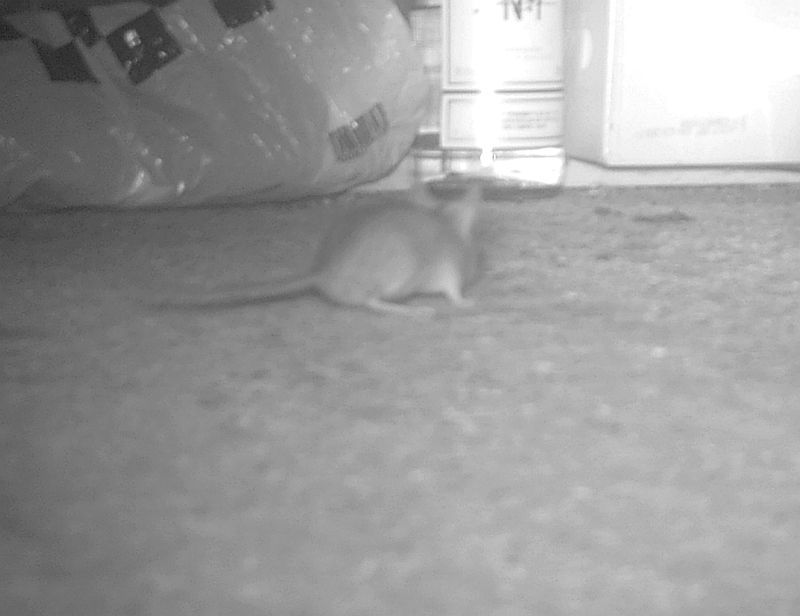 The trailcam was placed in the garage of my Area 5 garden, seen was a Wood Mouse Apodemus sylvaticus and at least 1 Hedgehog Erinaceus eoropaeus. Also seen was a Fox Vulpes vulpes crossing Caroline Drive in Area 5 at 20:00 by Ian Paine.
The trailcam was placed in the garage of my Area 5 garden, seen was a Wood Mouse Apodemus sylvaticus and at least 1 Hedgehog Erinaceus eoropaeus. Also seen was a Fox Vulpes vulpes crossing Caroline Drive in Area 5 at 20:00 by Ian Paine.
17/09/18
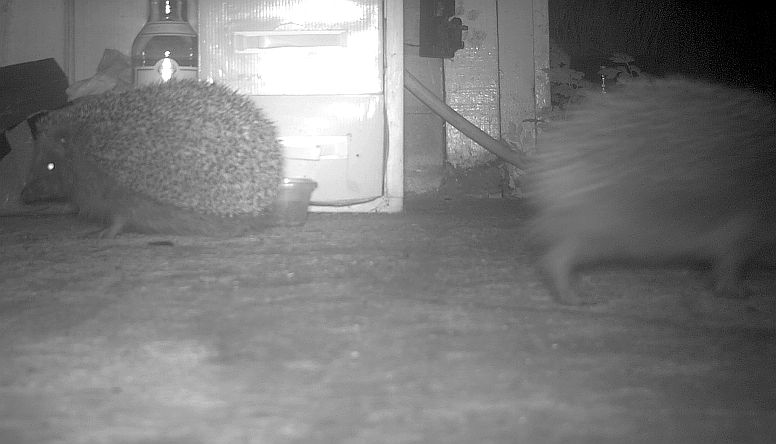 Caught on the trailcam in the early hours in my Area 5 garden, were at least 3 Hedgehog Erinaceus eoropaeus 2 adults and 1 young one, probably born this year .
Caught on the trailcam in the early hours in my Area 5 garden, were at least 3 Hedgehog Erinaceus eoropaeus 2 adults and 1 young one, probably born this year .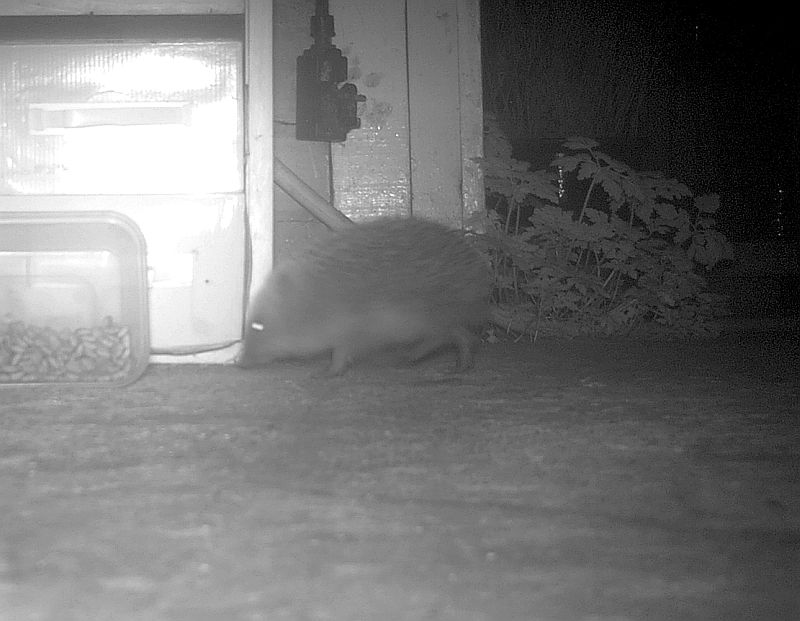 Until relatively recently there was no well established word for a baby hedgehog. Although the word kit had occasionally been used, and sometimes pup or piglet, most books about mammals just called them 'baby' or 'young' hedgehogs.However the current term appears to be Hoglet. Being of a certain age I shall however stick with what I know. Until relatively recently there was no well established word for a baby hedgehog. Although the word kit had occasionally been used, and sometimes pup or piglet, most books about mammals just called them 'baby' or 'young' hedgehogs.However the current term appears to be Hoglet. Being of a certain age I shall however stick with what I know.
13/09/18
At Old Forest Road Meadows a small Hedgehog Erinaceus eoropaeus was seen wandering about at 16:00 by Fran Stickler .
01/09/18
A Hedgehog Erinaceus eoropaeus was seen at 21:00 on the front lawn of my Area 5 garden .
Molluscs
Fish
Fungi
30/09/18
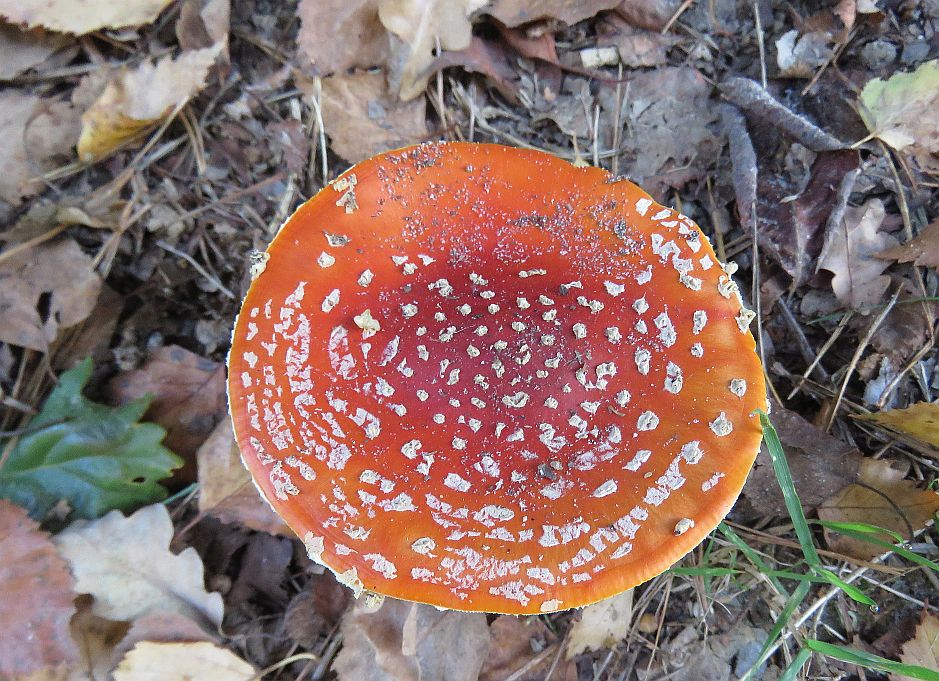 In Area 1 at Gorrick Woods, the instantly recognisable with white spots on a red domed top Fly Agaric Amanita muscaria toadstool can be seen.
In Area 1 at Gorrick Woods, the instantly recognisable with white spots on a red domed top Fly Agaric Amanita muscaria toadstool can be seen.
08/09/18
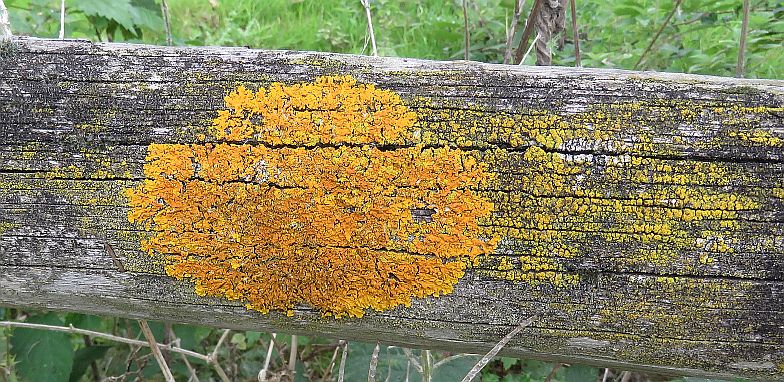 Classified as fungus, Lichen or lichenized fungus, is actually two organisms functioning as a single, stable unit. Lichens comprise a fungus living in a symbiotic relationship with an alga or cyanobacterium (or both in some instances). There are about 17,000 species of lichen worldwide. On the fence in Area 1 adjacent to the Emm at Ludgrove School was Common Orange Lichen Xanthoria parirtina .
Classified as fungus, Lichen or lichenized fungus, is actually two organisms functioning as a single, stable unit. Lichens comprise a fungus living in a symbiotic relationship with an alga or cyanobacterium (or both in some instances). There are about 17,000 species of lichen worldwide. On the fence in Area 1 adjacent to the Emm at Ludgrove School was Common Orange Lichen Xanthoria parirtina .
04/09/18
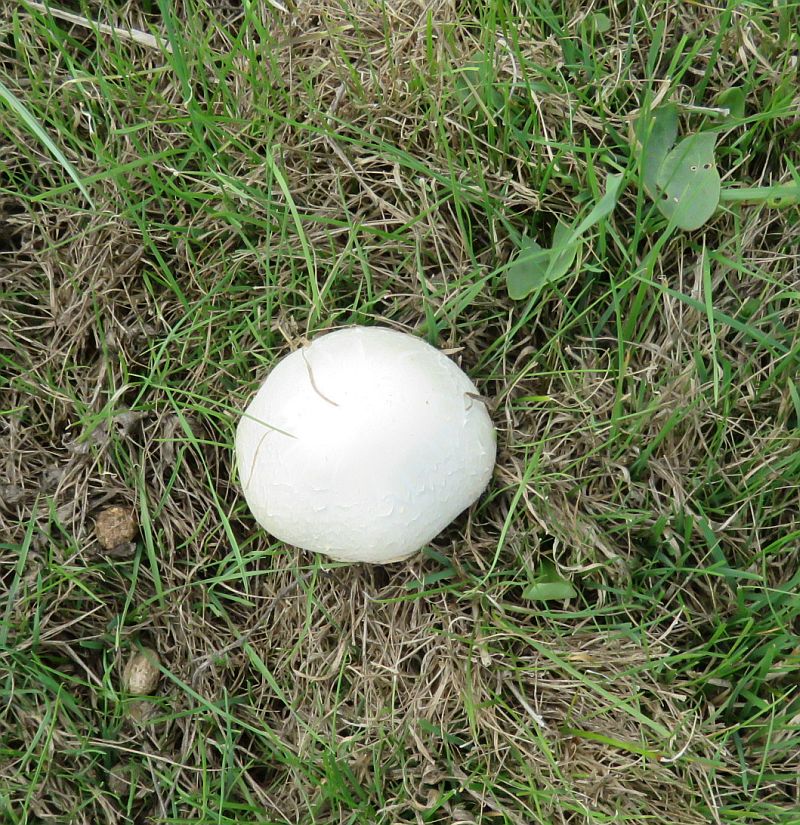 In the carpark field in Area 10 are what I believe to be several Field Mushroom Agaricus campestris . As I am by no means a Mushroom expert, please check before picking and eating any fungi.
In the carpark field in Area 10 are what I believe to be several Field Mushroom Agaricus campestris . As I am by no means a Mushroom expert, please check before picking and eating any fungi.
|









































